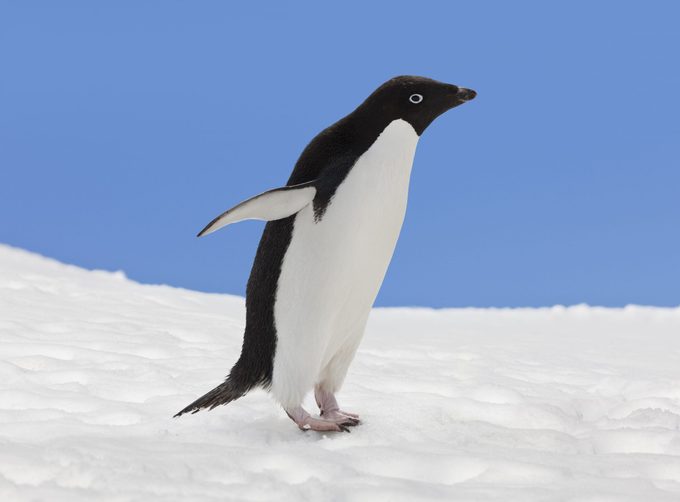Turns out penguins may not be the cute and cuddly creatures the world perceives them to be

7 Penguin Facts That Were Hidden for a Century

The world’s first penguin biologist to study a large colony of the animals up close, George Murray Levick, was marooned in 1911 for almost a year on Cape Adare in Antarctica, the site of the world’s largest Adélie penguin colony. While he was there, he amassed many penguin facts while conducting the world’s first serious study of the aquatic birds.
Many of his observations—but not all of them—were published in his book, Antarctic Penguins: A Study of Their Social Habits. Nearly a century later, it was revealed that Levick’s most shocking observations about the mating behavior of the penguins were left out of his published work. Award-winning scientist Lloyd Spencer Davis, author of A Polar Affair, which discusses Levick’s hidden findings, shares some of Levick’s observations of the penguin, as well as his own insights about the proclivities of penguins. Read on to learn about some of the scandalous penguin facts that finally surfaced after a century.
Get Reader’s Digest’s Read Up newsletter for more animal news, humor, cleaning, travel, tech and fun facts all week long.
Penguins engage in same-sex behavior

Levick describes in his zoological notes the reciprocal homosexual mountings between two male Adélie penguins, whereby one mounts the other, and then they swap places and repeat the performance. He refrained from referring to any of this in his book about penguins. “It could have been the same encounter I had observed on Cape Bird and then described in my own manuscript, which I had published as original research 83 years after Levick’s observations,” says Davis.
Penguins are not monogamous

Levick’s notes record several instances of penguins mating with more than one partner during the breeding season. Levick kept the penguin mate swapping that he observed out of his public writings. It was not until the 1990s that, while watching penguins intently, Davis and other penguin scientists observed that swapping partners was a frequent occurrence during the courtship period. “[It’s] like a penguin version of musical chairs, whereby females may move from one nest and male to another, two, or even three or more, times,” says Davis, who goes on to note he and his fellow researchers made a remarkable discovery, which is that “10% of female [penguins] cheat on their male partners, whipping away for a quickie with a neighbor then returning to their partners.”
Divorce occurs in penguin colonies
Davis discovered that, depending upon the season, about a third of Adélie penguins may pair up with a new partner from one season to the next, despite both members of the pair surviving the rigors of the Antarctic winter and their long migration. He notes the irony that the film March of the Penguins, about Emperor penguins, was presented as an example of an animal that represents “family values,” as Emperor penguins are even less disposed to “mating for life” than are Adélie penguins, with about 85% of them divorcing from one season to the next.
Some penguin sex is not consensual

Levick’s most shocking revelations concern non-consensual sex. His most extreme observation is of an injured female enduring copulation by four successive males as she struggles to get away, says Davis. Davis believes Levick’s observations and says they fit with male penguins. “We already know they are lacking in any form of discrimination, and from the male’s perspective, what’s there not to like about getting an unexpected copulation?” Davis says. He also says that he and his postdoctoral fellow discovered that the males would readily mount a stuffed toy penguin if given the opportunity.
Some penguin partners aren’t even alive
Levick recorded in his notes that he watched male penguins mounting and copulating with the corpses of dead penguins. Davis observed this behavior as well. It is no doubt part of the same phenomenon, whereby males can produce millions of sperm with every ejaculate, Davis says. Hence, the cost to them of an inappropriate mating is negligible. “By contrast, the female Adélie penguin passes on her genetic material in the form of eggs, and she produces just two of them each year. The females have a lot invested in each egg, and they need to be cautious about with whom and where they mate,” says Davis.
Female penguins find sneaky ways to get pregnant

Females sometimes sneak away from their partner to copulate with another male, then return to their partner. “Take any group of a dozen male Adélie penguins, and it is a fair bet that one of them will be infertile. Hence, from an evolutionary point of view, the advantage to the female penguin of her duplicitous behavior might be to help ensure that at least one of her eggs will be fertilized in the event that her partner happens to be sterile,” Davis says.
“Currency” is sometimes exchanged for sex in the penguin colony
Davis and his team discovered instances where females would have sex with another male penguin in exchange for a stone. The female would then take it back to her own partner and nest. “Stones really are the currency of the colony [and] in the penguins’ world, they are worth something. To them, they are really the equivalents of dollars or goats,” says Davis.
How the penguin proclivities came to light

Two years after returning from the Antarctic and one year after publishing his book about penguins, Levick wrote a short paper outlining the lurid side of penguins. However, he was not allowed to publish it. Instead, 100 copies were produced and circulated to a select group of scientists by the keeper of zoology at the Natural History Museum in London. But almost all those copies, except for two, were seemingly lost or destroyed.
Nearly a century later, in 2012, Douglas Russell, the senior curator of birds’ eggs and nests at the museum, would discover a surviving copy of the unpublished manuscript, and Levick’s observations about the sexual proclivities of penguins would remain censored no more.
Why trust us
At Reader’s Digest, we’re committed to producing high-quality content by writers with expertise and experience in their field in consultation with relevant, qualified experts. We rely on reputable primary sources, including government and professional organizations and academic institutions as well as our writers’ personal experiences where appropriate. We verify all facts and data, back them with credible sourcing and revisit them over time to ensure they remain accurate and up to date. Read more about our team, our contributors and our editorial policies.
Sources:
- Levick, G. Murray: Antarctic Penguins: A Study of Their Social Habits
- Davis, Lloyd Spencer: A Polar Affair: Antarctica’s Forgotten Hero and the Secret Love Lives of Penguins
- Encyclopedia of Australian Science and Innovation: “Levick, George Murray”
- Polar Record: “Dr. George Murray Levick (1876–1956): unpublished notes on the sexual habits of the Adélie penguin”
- American Scientist: “Evolution on a Frozen Continent”
- LloydSpencerDavis.com: “Biography”
- Natural History Museum: “Douglas Russell”























